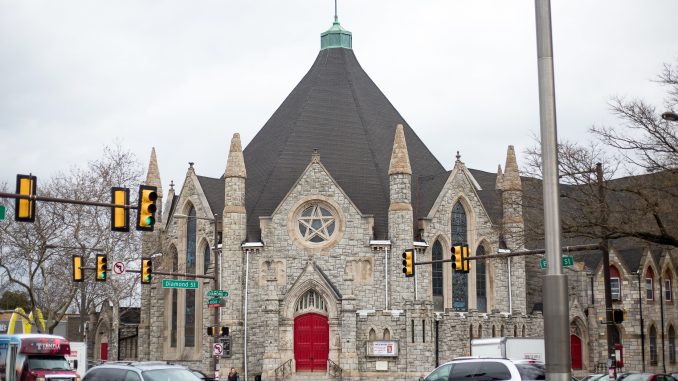
Rev. Michael Evans is leading Berean Presbyterian, a 140-year-old church on Broad Street near Diamond, through a time of “transformation and transition.”
“We’re on the cusp of changing,” Evans said. “It’s important because of what’s going on financially and with the ministry service.”
Evans wants to attract young members to Berean, a congregation of mostly people 70-years and older, he said.
“Church is not a top priority,” Evans said. “You find more people in the mall on Sunday than you do in church. You find more people at the football game or something like that. At one time, you couldn’t find anything else open but a church.”
Historically Black churches around Temple are facing declining attendance and deterioration of their buildings. The Temple News asked church leaders and congregants what it will take for the churches to endure through the future.
Berean Presbyterian Church
In 1955, Rev. Benjamin Glasco Sr. and the Berean family bought Bethlehem Presbyterian Church’s building on Broad Street near Diamond. The church has remained there ever since, Evans said.
Between 60 and 80 people attend service at Berean each week, Evans said.
“We have some financial hardships, but we’re optimistic,” said Alison King, Berean’s clerk of session.
Part of the church’s income comes from fundraisers and renting out space in the church, King added.
Temple rents space in Berean for its Pan-African Studies Community Education Program, King said. Temple’s acapella groups, Broad Street Line and Singchronize, also rent space. Other renters include Pennsylvania’s Department of Human Services and Narcotics Anonymous.
“We have to be more visible,” Evans said. “We have all this space. We have this resource that God has given us. How do we take this resource and be more functional in the community?”
The church will host a fundraiser, Berean Jazz Fest, on March 21, which attracts hundreds of attendees, Stewart said.
In January, Temple students and community residents gathered in Berean for a reading of Martin Luther King’s “I Have A Dream” speech, The Temple News reported.
“This church is the best experience that I had, because I got to be a part of so many things that I always wanted to do,” said Margaret Searles, who has attended Berean for 42 years. “And there are so many people I’ve met that I never thought I would meet.”
“There are so many places I have been in the world, but this tops it all,” added Searles, who lives on Duval Street near Morton in Mt. Airy.
Jones Tabernacle A.M.E. Church
Rev. Richard Wright, Jr. founded Jones Tabernacle on 20th Street near Susquehanna Avenue in 1930 after splitting from Morris Brown African Methodist Episcopal Church. This year, Jones will be celebrating its 90th anniversary with a “year of celebration” which includes a series of workshops for community residents and a neighborhood block party, The Temple News reported.
“We’re maintaining [our historical significance],” said John Griswold, Jones’ longest-attending member. “It’s become very difficult because of the size of the congregation. It’s way down.”
Griswold, 91, remembers when Jones Tabernacle had more than a thousand members. Now, membership is less than 200 people, said Rev. Miriam Burnett, Jones’ first female pastor.
“We still do community service, but it’s on a much smaller scale than it used to be,” said Griswold, who lives on 19th Street near North.
Today, the church has more than a dozen youth members.
“Our young people feel like they’re needed,” Burnett said. “And they respond appropriately. That’s not just me. The whole congregation grabs onto that.”
In addition to its membership challenges, Jones Tabernacle’s roof needs a multi-million dollar repair, Burnett said. Because it is a historic building, Jones Tabernacle must repair the roof with an expensive alternative to regular asphalt.
The church has started to raise money for the repair, Burnett said. Aside from repairs, Jones Tabernacle spends about $1,400 a month on oil for its heater, which must be turned on from September to April because of the church’s stone walls, she added.
The Church of the Advocate
The Church of the Advocate on Diamond Street near 18th is rich with national history. The episcopal church, consecrated in 1897, hosted the first national Black Power Convention in 1968, the National Convention of the Black Panther Party in 1970 and the ordination ceremony for the first 11 women to enter the Episcopal priesthood in 1974, according to a church pamphlet.
But, the church needs $7 million to renovate it, Billy Penn reported in October 2019. Rain water leaked through the roof and damaged some of the church’s murals from the 1970s.
The Advocate also needs a cooling system, fire code improvements, improvements to wheelchair accessibility, a fix for its eroding limestone and repairs to the plaster roof, Billy Penn reported. In total, the church needs $1.2 million for immediate repairs and another $5 million for additional repairs.
The Epsiscopal Diocese of Pennsylvania works with the Advocate to secure grants and funding.
“Our priority is to do any repairs that impact the safety of people in that church,” said Jennifer Tucker, the communications director for the Episcopal Diocese of Pennsylvania.
“The $7 million price tag to fix the roof and some of the other things is not something that we can afford to pay right now” she added. “We have 134 churches. Many of them are historic churches with their own infrastructure needs.”


Be the first to comment